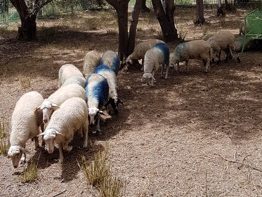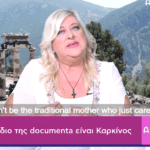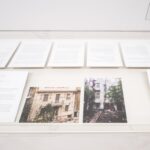The (missed) powers of indigo*
Fay Zika
I met Aboubakar Fofana on a mild winter afternoon of 2016 in the back garden of the Athens School of Fine Arts, one of the venues of documenta 14 “Learning from Athens.” Tall and upright, in flowing robe and long rasta hair, attentive and aloof, he stood out amongst a group of documenta 14 curators/collaborators and colleagues (artists and professors) from the Art School. I was part of this group because the courses I teach there on “Color theories and artistic practices” and “Landscape and garden theories” overlapped thematically with the artist’s project for the exhibition. He proposed to grow indigo plants in part of the garden, with the assistance of the gardeners and art students who would also contribute to the gathering of the plants, the boiling and/or pounding in order to extract the pigment and the creation of an installation based on cloth dyed with the pigment.
The project faced a number of logistical challenges: the state of the Art School garden was rather wild (and beautiful at that); the gardeners had been laid off due to the recent economic crisis (a garden seemed a luxury in times of scarcity); a studio which opened out into the garden had to be secured so that there was communication between the area of the plantation and the space in which the plants would be processed and the final work produced. The main problem, however, was a lack of good fertile earth for planting and gardeners to take on the project in its early stage. In its later stages, students could take care of the cultivation and gathering. I proposed to collaborate with the Agricultural University of Athens in hopes that they could offer us some good earth and a couple of gardeners to get the project started.
Documenta 14 researched the possibility, an appointment was made, and that was the last we saw of Aboubakar Fofana at the Athens Art School. The Agricultural University welcomed him and offered him its grounds. Apparently they were skeptical about allowing a plantation of non-indigenous plants, but they proposed other possibilities. So, Fofana changed the work to fit the new circumstances. Instead of his original idea, he imported the raw material for the dye, to be produced in a studio rented for this purpose at the Petralona area; and he was inspired by some of the other possibilities offered by the new institution and site.
***
It was not easy to find Aboubakar Fofana’s Ka touba Farafina yé (Africa Blessing). One had to find one’s way to the Agricultural University of Athens off the ancient Iera Odos (the Sacred Way), roam through the grounds to find a small olive grove where a group of sheep, whose wool was partially dyed in various shades of indigo blue, were grazing. There was a moment of peace, standing in the midst of the olive grove, the sheep grazing heedlessly, their blues merging with the greens, their motions complementing the swaying of the weeds, the rustling of the leaves and the scents from the surrounding trees in the crisp, late spring, Athenian morning. [fig. 1]
And yet it was a peace pregnant with forebodings.
It was uncertain what to make of this mobile map, as the 54 lambs were meant to represent the states of Africa. Were our minds supposed to wander off, as the artist suggested, to the vicissitudes of the African diaspora, “of the communities forced to leave their homelands due to war, unrest, harsh economic conditions, or abduction by human traffickers”? Was it a call to arms, a rise to consciousness in relation to African history and the plights of colonialism? Fofana himself pointed to different aspects of “the parable of sheep and human movement,” bringing out the nomadic character of both species, and the destruction wrought as the African continent is being carved up into borders and private lands. There was also an emphasis on beauty which appeared rather strange in the above context, unless it was meant as an aestheticization of the native: “Wherever the people of Africa go, they bring with them their culture and traditions, and combine them with the local element. And the places it reaches become richer and more beautiful thanks to this combination.”
What about the negative connotations of ‘herd psychology,’ possibly alluding to pathetic and manipulative aspects of the geopolitical situation to which the artist alluded? Couldn’t the alleged freedom of movement of the lambs be seen as a more sophisticated form of confinement in a zoo-like exhibit? And how far did cross-cultural exchange reach? As the exhibition took place in Greece, allusions to various sacrificial practices could have been raised -and questioned: from the ancient Greek sacrifice of animals to the Christian view of Jesus as “the Lamb of God who takes away the sin of the world.” The exhibition opened in spring, just around Orthodox Easter with its celebrated slaughtering of lambs and roasting them on a spit, in a combination of Christian tradition and semi-pagan Dionysian rites. The work offered a palimpsest of readings, but many may have been missed or gone unnoticed.
And what was the role of indigo? A natural pigment with various functions in several cultures: antiseptic, healing, symbolic, ceremonial, magical. Fofana refers to the “mysteries of indigo,” tracing his own career back to a childhood serendipity in his native Mali, when he crushed some green leaves and discovered that his hands were dyed blue: the transformation of one thing into another, the metamorphosis often related to artistic creativity. The artist researched and revived lost techniques of indigo cultivation and pigment extraction. He now grows the plant in his native Mali, physically assists in the production of the pigment, dyes cloth (or animals, in this case) in indigo and aspires to spreading the news of its powers. [fig. 2] However, there was no connection to its Greek etymology, indikon, a plant that apparently came from India, nor to its modern Greek counterpart, loulaki, or its many uses in Greece, from the antiseptic and bleaching effect of a small nugget used by my grandmother in the washing of linen to the large-scale painting of buildings’ walls, which has slowly fallen out of favor in modern Greece due to its association with past eastern influences. Drawing such connections might have raised fruitful discussions about nationalism, imperialism and colonialism; the migration of plants, animals and humans; and the (cross)cultural histories and symbolism of colors. All these connections were missed.
The use of animals raised other issues. The artist often referred to the continuum between human, animal and plant in his culture, a position known as animism. This applied as much to the production of natural indigo dye which requires soaking the plant in a vat ‘alive’ with bacteria, as to the ceremonial dyeing of the lambs in which artist and lamb plunged together in an indigo bath. Such views and ceremonial practices were not appreciated by Animal Rights activists, representing a totally different outlook and demonstrating with slogans like “Animals are not your canvas” or “The exploitation of animals is not art”. [fig. 3] This could have been the forum for important philosophical or interdisciplinary discussion on a number of issues: the relation and limits between humans and animals; speciesism, discrimination of members of one species against other species; the extension of human values (such as rights) to other species; the limits between traditional and western values or of indigenous versus foreign. But apart from an initial confrontation with members of Animal Rights organizations at the opening event at the Agricultural University auditorium, some continuing demonstrations on the site or in the media, and an act of aggression against the artist’s studio at Petralona, no dialogue was actually encouraged.
And who noticed the indigo bookmark of The documenta 14 Reader? A talisman for the exhibition, “a blessing from Africa” as the work is called? Given Fofana’s studio location in the Petralona area and documenta’s affiliation with the Benaki Museum, curator Monika Szewczyk discovered the Mentis traditional fibre and passementerie manufacture, one of the oldest in Greece, now part of the Benaki Museum. Given the artist’s previous experience with textiles, the idea of a special commemoration of the exhibition was incubated. It materialized as a bookmark made of indigo-dyed thread, which was woven into a thin ribbon at the Mentis factory, to be inserted in every documenta 14 Reader. [fig. 4] One association was certainly not missed: text and text-ile; Penelope’s weaving and unweaving, the writing and re-writing of the lores of the Odyssey, tracking the nostalgia for the homeland and the undoing of circumstance; the traditional “songs of the loom” where the rhythm of bodily or machine movements were compared to music and dance, the to-and-fro of parting and reunion, the forces and tensions of life. Yet couldn’t this talisman (phylahto in Greek) also mark a symbolic connection with modern Greece? A possible allusion to blue as its so-called national color, its skies and its seas; or even to the Greek blue-and-white flag as the blue marker streaks the white pages, interjecting into the written text and making a difference to its meaning?
*A shorter version of this text was published in Learning from documenta fanzine, Athens, October 2017.
Fay Zika is Associate Professor in Philosophy and Theory of Art and Vice-Rector of Research and Lifelong Learning of the Athens School of Fine Arts. Her research interests include colour theory and artistic practice, the senses and multimodal aesthetics, identity and gender issues, the relation between nature and art, the relation between philosophy, science and art. She has published articles in Greek and international journals, in collective volumes and exhibition catalogues, and is the author of Arts and Thoughts: Philosophical Investigations in Contemporary Art (Agra, 2018). She has organized and/or participated in several art projects such as Moment grec (Beaux Arts, Paris-Institut Franҫais d’Athènes, 2014), Tino Seghal “This Progress” (Roman Agora, Athens 2014), Documenta XIV (Athens-Kassel 2017), Learning from Documenta (2017), Garden Variations (Symptom Project-Amfissa 2019).
Sources
Johanna Macnaughtan, “Aboubakar Fofana”, excerpt from the documenta 14 Daybook, https://www.documenta14.de/en/artists/13516/aboubakar-fofana
“Ka touba Farafina yé (Africa Blessing). Aboubakar Fofana” [in Greek], documenta 14 calendar, 29 April 2017, opening and public discussion, Agricultural University of Athens. https://www.documenta14.de/gr/calendar/19684/ka-touba-farafina-y-
Aboubakar Fofana Instagram, http://www.thepicta.com/user/aboubakarfofana/401040419
Monika Szewczyk, “Meanwhile, Aboubakar Fofana contributes a text-ile to The documenta14 Reader”, posted in Notes on 03.10.2017, https://www.documenta14.de/en/notes-and-works/13201/aboubakar-fofana-text-ile
“Songs of the Loom: Working Rhythms of Circe and Aboubakar Fofana”, Minus Plato. Art and Education after documenta 14, 23 March 2017. http://minusplato.com/2017/03/songs-of-the-loom-working-rhythms-of-circe-and-aboubakar-fofana.html
Jessica Hemmings, “Aboubakar Fofana”, Selvedge Magazine 49 (2013): 65-71, http://www.jessicahemmings.com/aboubakar-fofana/
“The Agricultural University of Athens at documenta 14 ‘Learning from Athens’” [in Greek], 12 April 2017, https://www2.aua.gr/el/news-events/nea/geoponiko-panepistimio-athinon-stin-documenta-14-mathainontas-apo-tin-athina
Eleni Iliopoulou, “The artist who painted 54 sheep at documeta 14 said that the animals asked him to dye them!” [in Greek], www.zoosos.gr, 29 April 2017, https://www.zoosos.gr/o-kallitechnis-54-provata-stin-documenta-14-eipe-oti-ta-zoa-tou-zitisan-na/#axzz4jIYV3vlK
“Assumption of responsibility for the attack on documenta’s studio at Petralona” [in Greek and English], athens.indymedia.org, 24/05/2017, https://athens.indymedia.org/post/1573957/







